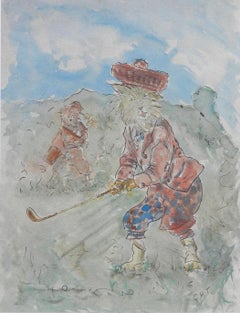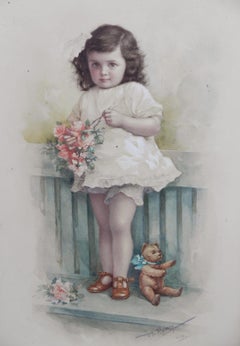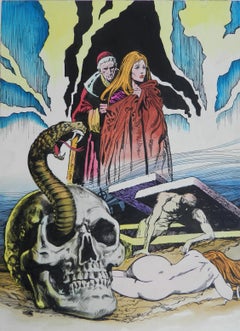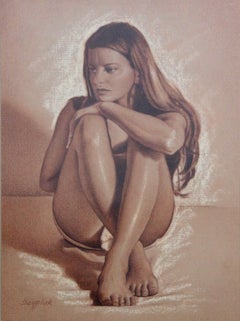Tryst d'Amour Figurative Drawings and Watercolors
to
4
12
2
7
4
10
2
Overall Height
to
Overall Width
to
1
1
7
5
3
2
2
2
2
2
1
1
1
1
1
1
1
1
3
9
1
3
1
2
1
11
11
3
3
2
Scottish Cats Playing Golf Midcentury Watercolor Signed Initials
Located in FR
Scottish Cats Playing Golf
Midcentury Watercolor with Signed Initials
Watercolor
The original has been stuck to an old Print, not related !
Will be deliv...
Category
1950s Other Art Style Animal Drawings and Watercolors
Materials
Watercolor, Cardboard
Skier Original Artist Signed Watercolor Mid Century c1952
Located in FR
Skier Original Artist Signed Watercolor Mid Century c1952
Signed by artist Robin Way
Frame included (no glass for shipping)
Good vintage conditi...
Category
1950s Other Art Style Figurative Drawings and Watercolors
Materials
Watercolor
Skiers Amusing Caricature Artist Signed Watercolor Mid Century c1952
Located in FR
Skiers Amusing Caricature Artist Signed Watercolor Mid Century c1952
Signed by artist Robin Way
Frame included (no glass for shipping)
Good vin...
Category
1950s Other Art Style Figurative Drawings and Watercolors
Materials
Watercolor
Young Child with Teddybear Watercolor by A Reng 1918 Stunning
Located in FR
Young Child with Teddybear Watercolor by A Reng 1918 Stunning
Superb painting fo a young girl with her Teddy Bear
Actual Image 33.5cms 13.19ins x 23.5cms 9.25ins
Category
1910s Realist Figurative Drawings and Watercolors
Materials
Watercolor, Cardboard
Original Painting Horror Comic L'Esorcista c1970
Located in FR
Original Painting Horror Comic L'Esorcista c1970
Horror Comic artwork
Unframed
Good condition with minor signs of age
Category
Mid-20th Century Other Art Style Figurative Drawings and Watercolors
Materials
Cardboard, Watercolor
19th Century Portrait of a Lady French Original Pencil Drawing signed 1883
Located in FR
19th Century Portrait of a Lady French Pencil Drawing signed and dedicated 1883
In its original oval ebonised frame
Decicated on the ba...
Category
1880s Victorian Portrait Drawings and Watercolors
Materials
Paper, Pencil
Caricature of a Film Star Golfer by Peter Hobbs Golf Original Painting c1950
By Peter Hobbs
Located in FR
Amusing original sketch caricature of a Golfer 'A Film Star'
From a series of golf caricatures by the UK artist Peter Hobbs, 1930-1994.
Peter Hobbs was a professional sports caricat...
Category
Mid-20th Century Figurative Drawings and Watercolors
Materials
Watercolor, Pen
Sketch Male and Female Nudes by Bob Brennen Ink and Wash Painting 1986
Located in FR
Male and Female Nude Ink and Wash Sketch by Bob Brennen 1986
A powerful study of the male and female form
Bob Brennen 1929-2011 born in Pittsburgh USA
An American sculptor and painte...
Category
1980s Other Art Style Nude Drawings and Watercolors
Materials
Ink, Watercolor
Girl In Garden With Flowers Original Watercolor English 19th Century
Located in FR
Girl in Garden 19th Century English Watercolor
Unframed on card
Charming
Overall good condition with some very minor foxing
Free shipping to UK and EU
H...
Category
Late 19th Century Victorian Portrait Drawings and Watercolors
Materials
Watercolor
Carnival Sketch by Bruno Locci Italian 20th Century Painter 1937-2010
By Bruno Locci
Located in FR
Carnival Caricature Sketch by Bruno Locci 1937-2010
20th Century Italian Artist
Watercolor on art paper
Mid Century an early work by Locci
Signed and titled
Bruno Locci was one of ...
Category
Mid-20th Century Contemporary Figurative Drawings and Watercolors
Materials
Watercolor
French 19th century Watercolor Villagers at waters edge manner Jules Hereau
Located in FR
French 19th century Watercolor Study of Villagers at waters edge unframed
Manner of Jules Hereau
Absolutely charming painting from a folio of works from a private estate sale all fro...
Category
1870s Impressionist Figurative Drawings and Watercolors
Materials
Watercolor
Caricature of a Lady Golfer by Peter Hobbs original watercolour sketch
By Peter Hobbs
Located in FR
Amusing original sketch caricature of a Lady Golfer
From a series of golf caricatures by the UK artist Peter Hobbs, 1930-1994.
Peter Hobbs was a profession...
Category
Mid-20th Century Figurative Drawings and Watercolors
Materials
Watercolor, Pen
Related Items
A girl II - XXI century, Contemporary Realistic Figurative Mixed Media Drawing
By Andrzej Szypluk
Located in Warsaw, PL
Contemporary realistic figurative mixed media drawing
PROVENANCE
Exhibited at Katarzyna Napiorkowska Gallery.
The Gallery is a primary representative for this artist.
The Gallery o...
Category
Early 2000s Realist Figurative Drawings and Watercolors
Materials
Chalk, Pastel, Cardboard, Pencil
The Abduction of the Sabine Women , a Renaissance drawing by Biagio Pupini
Located in PARIS, FR
This vigorous drawing has long been attributed to Polidoro da Caravaggio: The Abduction of the Sabine Women is one of the scenes that Polidoro depicted between 1525 and 1527 on the façade of the Milesi Palazzo in Rome. However, the proximity to another drawing inspired by this same façade, kept at the Ecole des Beaux-Arts, and to other drawings inspired by Polidoro kept at the Musée du Louvre, leads us to propose an attribution to Biagio Pupini, a Bolognese artist whose life remains barely known, despite the abundant number of drawings attributed to him.
1. Biagio Pupini, a Bolognese artist in the light of the Roman Renaissance
The early life of Biagio Pupini, an important figure of the first half of the Cinquecento in Bologna - Vasari mentions him several times - is still poorly known. Neither his date of birth (probably around 1490-1495) nor his training are known. He is said to have been a pupil of Francesco Francia (1450 - 1517) and his name appears for the first time in 1511 in a contract with the painter Bagnacavallo (c. 1484 - 1542) for the frescoes of a church in Faenza. He then collaborated with Girolamo da Carpi, at San Michele in Bosco and at the villa of Belriguardo.
He must have gone to Rome for the first time with Bagnacavallo between 1511 and 1519. There he discovered the art of Raphael, with whom he might have worked, and that of Polidoro da Caravaggio. This first visit, and those that followed, were the occasion for an intense study of ancient and modern art, as illustrated by his abundant graphic production.
Polidoro da Caravaggio had a particular influence on the technique adopted by Pupini. Executed on coloured paper, his drawings generally combine pen, brown ink and wash with abundant highlights of white gouache, as in the drawing presented here.
2. The Abduction of the Sabine Women
Our drawing is an adaptation of a fresco painted between 1525 and 1527 by Polidoro da Caravaggio on the façade of the Milesi Palace in Rome. These painted façades were very famous from the moment they were painted and inspired many artists during their stay in Rome. These frescoes are now very deteriorated and difficult to see, as the palace is in a rather narrow street.
The episode of the abduction of the Sabine women (which appears in the centre of the photo above) is a historical theme that goes back to the origins of Rome and is recounted both by Titus Livius (Ab Urbe condita I,13), by Ovid (Fasti III, 199-228) and by Plutarch (II, Romulus 14-19). After killing his twin brother Romus, Romulus populates the city of Rome by opening it up to refugees and brigands and finds himself with an excess of men. Because of their reputation, none of the inhabitants of the neighbouring cities want to give them their daughters in marriage. The Romans then decide to invite their Sabine neighbours to a great feast during which they slaughter the Sabines and kidnap their daughters.
The engraving made by Giovanni Battista Gallestruzzi (1618 - 1677) around 1656-1658 gives us a good understanding of the Polidoro fresco, allowing us to see how Biagio Pupini reworked the scene to extract this dynamic group.
With a remarkable economy of means, Biagio Pupini takes over the left-hand side of the fresco and depicts in a very dense space two main groups, each consisting of a Roman and a Sabine, completed by a group of three soldiers in the background (which seems to differ quite significantly from Polidoro's composition).
The balance of the drawing is based on a very strongly structured composition. The drawing is organised around a median vertical axis, which runs along both the elbow of the kidnapped Sabine on the left and the foot of her captor, and the two main diagonals, reinforced by four secondary diagonals. This diamond-shaped structure creates an extremely dynamic space, in which centripetal movements (the legs of the Sabine on the right, the arm of the soldier on the back at the top right) and centrifugal movements (the arm of the kidnapper on the left and the legs of the Sabine he is carrying away, the arm of the Sabine on the right) oppose each other, giving the drawing the appearance of a whirlpool around a central point of support situated slightly to the left of the navel of the kidnapper on the right.
3. Polidoro da Caravaggio, and the decorations of Roman palaces
Polidoro da Caravaggio was a paradoxical artist who entered Raphael's (1483 - 1520) workshop at a very young age, when he oversaw the Lodges in the Vatican. Most of his Roman work, which was the peak of his career, has disappeared, as he specialised in facade painting, and yet these paintings, which are eminently visible in urban spaces, have influenced generations of artists who copied them abundantly during their visits to Rome.
Polidoro Caldara was born in Caravaggio around 1495-1500 (the birthplace of Michelangelo Merisi, known as Caravaggio, who was born there in 1571), some forty kilometres east of Milan. According to Vasari, he arrived as a mason on the Vatican's construction site and joined Raphael's workshop around 1517 (at the age of eighteen according to Vasari). This integration would have allowed Polidoro to work not only on the frescoes of the Lodges, but also on some of the frescoes of the Chambers, as well as on the flat of Cardinal Bibiena in the Vatican.
After Raphael's death in 1520, Polidoro worked first with Perin del Vaga before joining forces with Maturino of Florence (1490 - 1528), whom he had also known in Raphael's workshop. Together they specialised in the painting of palace façades. They were to produce some forty façades decorated with grisaille paintings imitating antique bas-reliefs.
The Sack of Rome in 1527, during which his friend Maturino was killed, led Polidoro to flee first to Naples (where he had already stayed in 1523), then to Messina. It was while he was preparing his return to the peninsula that he was murdered by one of his assistants, Tonno Calabrese, in 1543.
In his Vite, Vasari celebrated Polidoro as the greatest façade decorator of his time, noting that "there is no flat, palace, garden or villa in Rome that does not contain a work by Polidoro". Polidoro's facade decorations, most of which have disappeared as they were displayed in the open air, constitute the most important lost chapter of Roman art of the Cinquecento. The few surviving drawings of the painter can, however, give an idea of the original appearance of his murals and show that he was an artist of remarkable and highly original genius.
4. The façade of the Milesi Palace
Giovanni Antonio Milesi, who commissioned this palace, located not far from the Tiber, north of Piazza Navona, was a native of the Bergamo area, like Polidoro, with whom he maintained close friendly ties. Executed in the last years before the Sack of Rome, around 1526-1527, the decoration of Palazzo Milesi is considered Polidoro's greatest decorative success.
An engraving by Ernesto Maccari made at the end of the nineteenth century allows us to understand the general balance of this façade, which was still well preserved at the time. The frescoes were not entirely monochrome, but alternated elements in chiaroscuro simulating marble bas-reliefs and those in ochre simulating bronze and gold vases...
Category
16th Century Old Masters Figurative Drawings and Watercolors
Materials
Ink, Gouache, Pen
François-Édouard Picot (French 1786-1868) Greek Comedy Play 19th Century Drawing
By François-Édouard Picot
Located in Meinisberg, CH
François-Édouard Picot
(French, 1786 – 1868)
Ancient Greek Comedy Play
• Pencil Drawing on laid paper behind decorative matting, visible image, ca. 10.5 x 15.5 cm
• Modern Glased frame, ca. 27 x 33 cm
• Signed "Picot fecit" lower left
• As we photographed through glass, there are reflections in the images
Worldwide shipping is complimentary - There are no charges for handling & delivery
Here we have the somewhat unusual, yet typical subject matter François-Édouard Picot was interested in depicting. Shown is a scene from an ancient Greek comedy play. The previous owner has noted on the back, that this image was copied from an ancient Greek stone relief.
François-Édouard Picot was born on the 10th of October in 1786 in Paris, France. He studied with various masters and became well known for his historical and mythological subjects. In 1812 he won the second prize in the Prix de Rome competition and after that success, went on to exhibit at the Paris Salon, where in the year 1819 he won a first-class medal for his neoclassical L'Amour et Psyché, which today hangs in the Louvre in Paris. He regularly exhibited his work in the salon up to 1839. He taught several young great artists at his elitist studio and was known for accepting only very few students, which included William Bouguereau, Gustave Moreau, Cabanel and Paul Seignac...
Category
Early 19th Century Naturalistic Figurative Drawings and Watercolors
Materials
Laid Paper, Pencil
Free Shipping
H 10.63 in W 13 in D 1.19 in
Costume drawings for ‘Ambassadeur de Siam’ and ‘La Sultana Reine’
Located in Amsterdam, NL
Joseph-Marie Vien (1716-1809)
‘Ambassadeur de Siam’ and ‘La Sultana Reine’
Both titled lower centre, the drawing of the ambassador inscribed with colours intended for the prints, e...
Category
Mid-18th Century Old Masters Figurative Drawings and Watercolors
Materials
Paper, Pencil
Free Shipping
H 9.26 in W 6.89 in D 1.19 in
Liber Mystia XLIII
By Henry Hablak
Located in Philadelphia, PA
"Liber Mystia XLIII" is an original artwork by Henry Hablak made of gouache, ink, and colored pencil on paper measuring 16.25"h x 12.25"w framed and 14"h x 11"w unframed.
Henry Habl...
Category
2010s Contemporary Figurative Drawings and Watercolors
Materials
Paper, Ink, Gouache, Color Pencil
Cowboy in the Canyon, Small Contemporary Multicolor Abstract Figural Landscape
By Tiffanie Mang
Located in Soquel, CA
Small-scale yet bold multi-colored abstracted figurative landscape of a horse rider in a canyon (a study after Edgar Payne’s works) by Tiffanie Mang (Ameri...
Category
2010s American Impressionist Figurative Drawings and Watercolors
Materials
Gouache, Cardboard
H 9.5 in W 9.5 in D 0.13 in
The Flower Seller - French Realist Figurative Watercolor by Victor Gilbert
By Victor Gabriel Gilbert
Located in Marlow, Buckinghamshire
Signed figurative watercolour on board by French realist painter Victor Gabriel Gilbert. The work depicts a flower seller at her market stall selling beautifully coloured bouquets of...
Category
Early 1900s Realist Figurative Drawings and Watercolors
Materials
Board, Watercolor
Fawn
By Henry Hablak
Located in Philadelphia, PA
"Fawn" is an original ink, colored pencil, and gouache on paper artwork by Henry Hablak measuring 30"h x 22"w.
Henry Hablak is a tattoo artist and illustrator based out of Philadel...
Category
2010s Contemporary Animal Drawings and Watercolors
Materials
Paper, Ink, Gouache, Color Pencil
Persephone, 19th Century Classical French Academy Drawing
Located in Cotignac, FR
19th Century French Academy drawing of a classical maiden, signed Xavier Rendeley bottom right, numbered and dated 2nd April 1883. Presented in ...
Category
1880s Academic Figurative Drawings and Watercolors
Materials
Paper, Chalk, Pencil
H 23.5 in W 19.5 in D 1 in
Freya (Seated Backwards), Mixed media on grey board
By Howard Tangye
Located in London, GB
Howard Tangye (b.1948, Australia) has been an influential force in fashion for decades. Lecturing at London’s Central Saint Martins for 35 years, including 16 years as head of BA Wom...
Category
2010s Contemporary Figurative Paintings
Materials
Other Medium, Archival Paper, Handmade Paper, Pen, Felt Pen, Permanent M...
Citroen 15CV - Contemporary Watercolor & Ink Painting, Vintage Car, Realistic
By Mariusz Szałajdewicz
Located in Warsaw, PL
Mariusz Szalajdewicz (b. 1974)
Studied at the Faculty of Architecture at Warsaw University of Technology, where he mastered the drawing skill. Architect and urbanist, illustrator.
Category
21st Century and Contemporary Realist Figurative Drawings and Watercolors
Materials
Paper, Ink, Watercolor
Antique Italian Painted Hand Fan in a Glass Case
Located in Palm Beach, FL
Impressive 19th century Italian hand fan, remarkably preserved with silvered metal sticks and guards depicting ancient gods, palm trees and classical emblemes. The paper leaves are h...
Category
Mid-19th Century Rococo More Art
Materials
Silver







